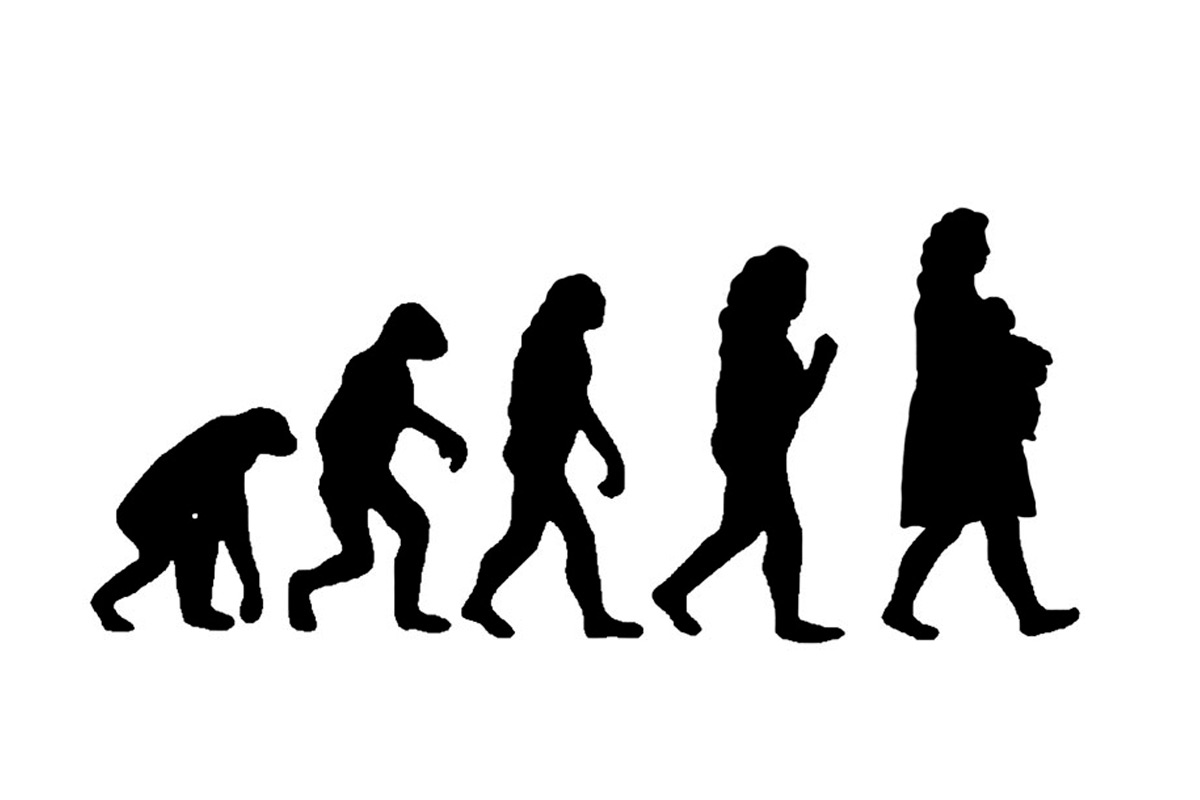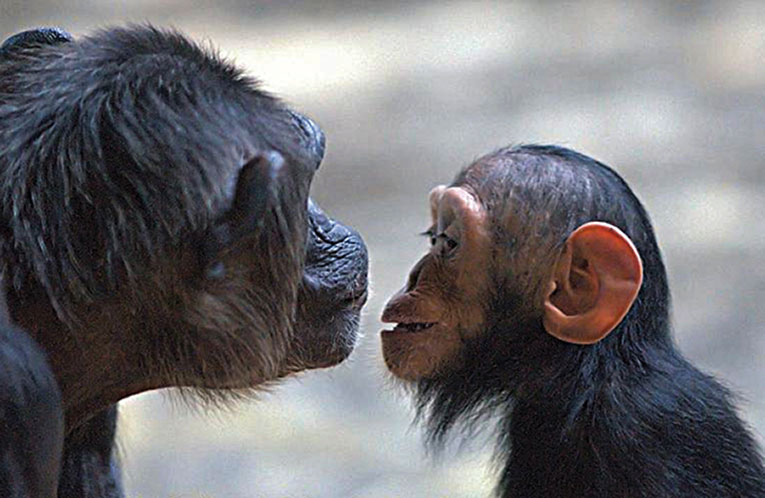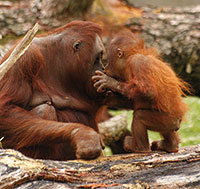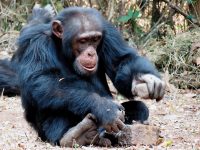
Great apes are born vulnerable and dependent and require a long period of upbringing. Maternal empathy, communication skills and techniques for gathering and preparing food can greatly enhance their offspring’s chances of survival. These facts lead to certain hypotheses about the origins of proto-moral, proto-linguistic and proto-technological behaviour in hominids and the ways in which they could have co-evolved and contributed to the process of humanization. This article contrasts this pluralistic, maternity-centred approach with the traditional monist, male, war-centred view of the origins of humanity, as depicted, for example, at the start of Kubrick’s 2001.
Most people envision the dawn of humanity like Kubrick. The first minutes of 2001: A Space Odyssey shows a group of hominids that come across an oasis. Just when they are revelling in the water, another group drives them out of this small paradise. With his hopes dashed one of the banished ape-men examines the remains of a dead animal and accidentally finds that a thick femur can break the animal’s ribs. He returns, brandishing it like an avenging angel, knocking down the rival leader and thus retrieves the oasis –he celebrates the victory by throwing the femur up into the air. The bone spins, for a few seconds representing evolution, rotating like a spacecraft.
I did not imagine it otherwise. When Chris Bertram told me that he projected this scene at the beginning of his seminars on Marxism, I thought it was fine. I warned him that for Marx history was the history of how productive –and not destructive– forces had developed. But that might not change things that much. Be it the pestle or the mortar, that bone was the key to our «special» odyssey: the beginning of the journey during which our species broke away from mere animality. An idea has been forming in my mind over the last twelve years, during the Great Ape Project, and I explain it so people can tell me if I’m wrong, but it has little to do with this bone-breaking Adam.
«All hominids take great care during pregnancy, avoiding danger, political struggle and rugged topography. Once the baby is born, we are fully dedicated to caring for it»
Hominids: male and female
Hominids or great apes are humans –or humanese according Jesús Mosterín– and pongids: orangutans, gorillas, bonobos and chimpanzees. Orangutans were the first to split from the evolutionary lineage, then gorillas, followed by humans and finally bonobos and chimpanzees. Hominids are great tailless apes with cerebral asymmetry and the dental formula 2/2, 1/1, 2/2, 3/3 = 32, capable of bipedal walking; in the old world, we lived in monogamous, heterosexual groups and slept in caves or on tree platforms. We have few children, usually one per pregnancy, that are born helpless and dependent –they grow up very slowly and make a lot of work.
Orangutans can spend a decade teaching their child how to survive in the jungle, implying effortful dedication that means they have only one child every eight years. With six years of breastfeeding and nearly nine months of pregnancy, the shortest interval would be seven, if they get pregnant at once. As they don’t usually have their first child until the age of sixteen, have very few children and take great care of each, they manage to achieve very low infant mortality rates. The hominid that finishes raising its young the soonest is the mountain gorilla, though it still breastfeeds its offspring for four years, and educates and protects them for many more.
All hominids take great care during pregnancy, avoiding danger, political struggle and rugged topography. Once the baby is born, we are fully dedicated to caring for it –investing a great deal of time and effort in making sure it prospers. We carry it around in our arms (the right-handed, on the left) until they can be carried on our back, we let them sleep with us even if it prevents us sleeping deeply ourselves, and bring them up with patience. Long after breastfeeding is over, they continue to rely on us, materially and emotionally, and accompany us on short and long trips. Education is essential to their survival, they have to learn to make nests, know what they can eat in each season, how to obtain food, identify poisonous ones or know which plants to eat if they have certain symptoms. Belonging to cultural species, only partly governed by instinct, we have much to learn when it comes to survival.

When we have a baby, we are fully dedicated to caring for it –investing a great deal of time and effort–. We carry our children around in our arms, let them sleep with us and bring them up with patience. Even long after breastfeeding is over, they continue to rely on us, materially and emotionally. / © J. French
Protomoral behaviour
In order to perform all these duties with dedication and perseverance, even when we are very tired or aching, nature has designed us to feel immense love for our children. It is so strong it extends to whatever looks like our children. Our eyes follow other babies and children, we see a hungry orphan and sometimes –for a moment or forever– we are moved to the point of wanting to adopt it. Even an animal with an overly big head and large eyes, trembling with hesitant steps, seems adorable. We are moved when we see it tottering and calling its mother, and are touched by every needy and vulnerable being. Thus, according to Darwin in Descent of Man, our sympathies «extend to men of all races, to the imbecile, the maimed, and other useless members of society, and finally to the lower animals.»
That’s why the chimpanzee Washoe risked her life by jumping into a canal to save a young newcomer (Fouts and Fouts, 1998). Likewise when the bonobo Kuni saw a starling crash against a windowpane she picked it up, carefully spread out its wings and tried to help it fly. She climbed the tallest tree, clinging on with her feet leaving her hands free to hold the bird, which she cared for all day till it could fly (De Waal, 2005a, b).
All pongids exhibit protomoral behaviour, but several patterns of behaviour are more frequently observed in females such as adopting or caring for another’s offspring, even those belonging to other species, feeding older mothers when they can no longer climb, comforting those who suffer, distracting them from pain, calming conflict and helping others to patch up. These patterns go beyond hominid species and cultures and are manifest early on. Apparently, young females are more responsive to others’ weeping or expressions of pain shortly after birth and perceive and inherit maternal stress, which male children do not inherit because they do not perceive it (Brizendine, 2006). Modern men are more involved in taking care of their children and their elderly parents, but not to the same extent as women, who are still more involved in voluntarily caring for children or unrelated elderly. Almost all those who ring up Cooperatour, asking them to find a place in the Third World where they can spend the summer helping others, are women, and though the animal rights movement has highly visible male leaders, those doing the work behind the scenes are women. Female rates for crime and violence are also very low. In the United Kingdom, for example, only 3% of inmates are women. These women’s arrest also tends to be related to their status as immigrants, drug addicts or prostitutes. The rest of Europe reflects similar figures, which are also consistent with those of the FBI (Giddens, 1988).
«Education is essential to our offspring’s survival. Belonging to cultural species, only partly governed by instinct, we have much to learn when it comes to survival»
When we say someone is inhuman, or is an animal, we are not referring to an inability to wield a cudgel but rather a lack of compassion. We endorse of the death of an alien or robot in a film when it lacks empathy or humanity, but not due to its technological development. Therefore, if there is a unique feature that could be said to humanize, it is empathy, a reaction that favours oxytocin production, which floods our bodies at childbirth. The cudgel is barbarism, empathy is civilization.
Protolinguistic behaviour
Hominids are recognized facially, and read intentions and emotions on the faces of others. As hominid mothers we spend a great deal of time watching over our babies to guess what they feel: cold, heat, hunger, fear, sleepiness, thirst, wind, itching… We need to communicate as much as we need to breathe, and have developed a great ability to perceive what is happening to others. This ability is not well-developed in men who have always said they cannot understand women; the majority also have difficulty interpreting young children. Meanwhile, females respond to more subtle signs, like a baby’s moan, even though it is not actually crying (Brizendine, 2006).

Hominids are recognized facially, and read emotions on the faces of others. As hominid mothers we spend a great deal of time watching our babies faces, trying to figure out if they feel fine, if they are ill, if they are hungry or scared, etc. The picture shows a chimpanzee observing her baby. / © [email protected] & Monkey World
And if a child’s moan puts a mother on the alert, the sound of a lullaby signals a child to lower its guard and relax, knowing that mother is not only close by, but awake. Perhaps that is why so many intelligent mothers, including some whales, croon to their children. Being more empathetic, they can better interpret nonverbal behaviour and verbal skills are also their specialty. Girls learn to speak earlier than boys and tend to talk more (Bernardine, 2006).
These behavioural patterns are also observed in primates. Rhesus monkeys, for example, communicate and often groom each other using many different tones, including those known as motherese –a language employing high musical tones that human and primate mothers use to communicate with infants–. Meanwhile, males employ a smaller range of tones and spend whole days in silence (Green and Semple, 2009). Speaking is extremely useful in educating the young, to protect and defend interests by setting up alliances. Not having the cudgel-wielding option to resort to, there is no choice but to talk and reach a compromise. Some women speak more in the first half of the menstrual cycle and during adolescence because, like empathy, talkativeness may also have its hormonal counterpart (Brizendine, 2006).
Prototechnological behavior
In addition to nests and tools, gorillas build bridges, and walk upright using a cane to cross waterlogged and slippery terrain. Recently a gorilla was caught on film using a stick to measure the depth of a river, to know where best to cross, and perhaps where to cross her offspring. However, gorillas are the hominids that use tools the least because they need them less, being able to resort to brute force. Something similar could explain why there are more observations of pongids using tools. The females need more food during pregnancy, breastfeeding, and for their children, they are not as strong and pass their learned behaviour on to their children.
«Females are those least able to resort to brute force and those most in need of food, and being under greater pressure to sharpen their wit, invent and transmit these achievements to others»
To teach a young orangutan to make a padded nest by folding flexible twigs like springs, and a leafy roof carefully constructed so that the rain runs off properly, requires great motherly dedication. The nests are made high up and a mistake could prove fatal. And then there is the use of different plants as medicines, umbrellas, gloves, napkins, tongs, back-scratchers and other things. Chimpanzees also have a lot to explain to their young (Huffman and Wrangham, 1996). Some groups specialize in stone tools while others prefer to make wooden ones. In times of drought, some make sponges by chewing plants and then use them to collect water from the trees while others tear water-rich roots and carry them like a water-flask. Some chimps fish termites using peeled rods while others sweep them up with brushes made by fraying stems. Mothers have to convey all this to their young, who would otherwise die in the jungle, as any of us or those born in zoos would. Mother-teachers develop teaching methods by dividing each task up into simpler ones, which the children repeat and practice like a drill (Boesch, 1991). This also helps to refine the tools and their use.
According to the socio-ecological rule governing vertebrates: «females to food, males to females» (Emlen and Oring, 1977); thus, an alpha female has a lot of food while an alpha male has many females. Male reproductive success depends on access to females. Females can always find volunteers for sex, their problem is food: they must have enough food during pregnancy and lactation, and then enough for their offspring. Just like destructive forces, productive forces have also been considered a masculine affair. However, females are those least able to resort to brute force and those most in need of food, and being under greater pressure to sharpen their wit, invent and transmit these achievements to others.

Orangutans can spend a decade teaching their offspring how to survive in the wild, so they have very few children and childcare is intensive, which actually means they achieve very low child mortality rates./ © Hauke Steinberg
Richard Wrangham believes the key driving force behind humanization is cooked food, and explains that humans have a smaller belly than other hominids and a slightly different mouth and jaws because cooked food is much easier to digest (Wrangham, 2009). Well, if this is the key to humanization, it was probably not just a man thing either, because females are the ones who prepare, peel, clean, shell, crush or even pre-chew food –just like many Africans do even today– for their offspring, and these young are less tolerant to unchopped or uncooked food.
The possible coevolution of these three types of behaviour
There need not be a single key driving force behind humanization. Several types of behaviour could have coevolved. For example, apes that have learned sign language, used by deaf-dumb people, employed the terms good and bad spontaneously to refer to their own or others’ actions. The orangutan Chantek, for example, called people, dogs and birds that bothered him «bad», and called himself «bad» when he annoyed the cat (Cavalieri and Singer, 1998). Having called a number of things «bad», makes it easier to see what they have in common. This may illustrate how language development may have contributed to moral development. And also the ability to speak probably contributed to technological development. For a start, when we seek the right word, the right tools or the proper manipulation technique, we use almost the same area of the brain, and speaking teaches us to fit pieces into a sequence and muscularly predict the next sound to pronounce, as we do with a manual task. At the University of Oregon, Helen Neville and Scott Frey studied how speech has positive effects on technical development1. Undoubtedly, language skills helped us teach different techniques to one another and, in turn, perhaps some cooking techniques helped us to talk. Food preparation, which has freed us from our old belly, also released our mouth from the rigors of raw food. This must have helped in specialising our mouth for speaking. A chimpanzee can master sign language, but its oral speech ability goes no further than mama, papa, cup and up (Savage-Rumbaugh et al., 1986). There are several factors involved, including the position of the larynx, which is higher in chimpanzees and human infants than in humans of speaking age, also our delicate lips seem more well-suited to reproducing our wide variety of consonants that theirs, which are more muscular and better adapted to their raw diet.
Technology and a moral sense could also have coevolved. One possible reason occurred to Thomas Hobbes: nobody would make anything, not even food, knowing that it is going to be stolen. So we had to develop some sort of copyright system, combined with helping the needy, so that even the hungry would respect something prepared by another.
Love (baby) and not war
Long before May 1968 when 2001 was released in Europe, and even before Heraclitus stated «war is the father of all things», there was talk of the phoenix and progress through destruction. However, numerous recent findings paint a picture of humanization that is not war-centred.

To make us perform all the tasks necessary for childcare and education, nature has designed hominids to feel an immense love for our children. The picture shows a gorilla with her baby./ Mary Kilbreath
According to genomic and fossil data, it seems that at the beginning our species were very few in number. Thus we had no great need to engage in a fratricidal war, and being so few, it could have been the end of us. However, it is thought that, at least among males, there were high levels of aggressiveness. Then we calmed down, we became less brutish, less polygamous, sexual dimorphism decreased, our brain grew as did the father’s role, and we became «more human». It is likely that rather than a single factor, several factors coevolved, although perhaps all were linked to the same challenge: how to help our offspring survive. Among pongids, this task is performed by females. Orangutans tend to leave it up to others, gorillas form a harem and chimpanzees and bonobos tend to promiscuity. Modern humans have a greater tendency to monogamy, and fathers are more involved in childcare. But to find our origins we must think back to how our ancestors were. We know that we inherited evident sexual dimorphism from them and the ten hallmarks of polygamy: more men are born, more die, they die sooner, they are larger, more competitive, daring and violent, play more aggressive games and are less selective and more willing to mate. The further back we go, the greater the dimorphism and the less likelihood that males took care of their offspring (Lehman, 1998). And to find our origins means going back a long way, millions of years, because even in the Homo erectus era, for instance, someone was already cooking for and looking after the helpless. And if bringing up offspring is crucial to a species’ success, then empathy, communication and preparation of food were, and are, all key to the survival of one’s progeny and the evolution of our species, so we should have a very different image of the humanizing process. What we have now is an addition to our traditional view of history as being a succession of male and military triumphs. We should pay more attention to modest everyday tasks such as caring for those in need, providing safe and nutritious meals and teaching motherese.
«If there is one unique feature that could be said to humanize, it is empathy, a reaction that favours oxytocin production, which floods our bodies at childbirth. The cudgel is barbarism, empathy is civilization»
The position women hold in our society is not only reflected in the low status of their tasks, but also in the evolutionary theories that have dominated our imagination. Jared Diamond gives several examples of male fantasies disguised as science, among which is the figure of the great hunter. In fact, apes are mostly vegetarians and in the case of the few remaining hunter-gatherers, their families live mainly on what the females collect. Males sometimes catch small prey and then, adds Diamond, they celebrate their exploits. Big-game hunting is essential in colder regions, but when we settled there we were already modern humans (Diamond, 1994). Furthermore, according to Wrangham, the safety implied by a meal collected and cooked by females, provided males the time and the energy to hunt. Otherwise, males could only have gone hunting like chimpanzees do: sporadically, opportunistically and briefly, before returning to the task of chewing slowly but surely through enough roots and shoots to recover the energy spent that day. However, despite the wide readership of authors like Diamond or Wrangham, the idea of evolution as a male achievement continues to dominate, seen as a question of punches and blows, not as a question of language, cuisine or empathy. Kubrick subtitled his scene «The dawn of man», but if ontogeny mimics phylogeny, perhaps it dawned on woman first.
1. See episode three of the series The Human Spark (Back to text)
BIBLIOGRAPHY
Boesch, C., 1991. «Teaching Among Wild Chimpanzees». Animal Behaviour, 41: 530-32.
Brizendine, L., 2006. The Female Brain. Random House. Nueva York.
Cavalieri, P. & P. Singer, 1998. The Great Ape Project. London: Fourth Estate.1994 also published by St. Martin’s Press, New York.
De Waal, F., 2005a. Our Inner Ape. Granta Books. Londres.
De Waal, F., 2005b. «Morality and the Social Instincts».In: The Tanner Lecture Library. The University of Utah. Salt Lake City.
Diamond, J., 1993. The Third Chimpanzee. Harper Perennial. NY.
Emlen, S. & L. Oring, 1977. «Ecology, Sexual Selection, and the Evolution of Mating Systems». Science, 197(4300): 215-223.
Fouts, R. & D. Fouts, 1998. «Chimpanzees’ Use of Sign Language». In: Cavalieri, P. & P. Singer (eds.). The Great Ape Project. London: Fourth Estate.1994 also published by St. Martin’s Press, New York.
Giddens, A., 1988. Sociology. Polity. Oxford.
Greeno, N. & S. Semple, 2009. «Sex Differences in Vocal Communications Among Adult Rhesus Macaques». Evolution and Human Behaviour, 30: 141-145.
Huffman, M. & R. Wrangham, 1996. «Diversity of Medicinal Plant Use by Chimpanzees in the Wild». In: Wrangham, R. et al (eds.). Chimpanzee Cultures. Harvard University Press. Cambridge MA.
Lehman, A., 1998. «The Origin of Culture». Human Evolution: Evolution and the Structure of Health and Disease.
Pilbeam, D., 1982. «New Hominoid Skull Material from the Miocene of Pakistan». Nature, 295: 232-234.
Savage-Rumbaugh et al., 1986. «Spontaneous Symbol Acquisition and Communicative Use by Pygmy Chimpanzees». Journal of Experimental Psychology, 115(3): 211-235.
Wrangham, R., 2009. Catching Fire. How Cooking Made us Human. Basic Books. NY.
Acknowledgements: I would like to thank Alberto Casal, Jaume Bertranpetit, Robin Dunbar, Carl Hoefer, Òscar Horta, Marisa Iglesias, Carmen Maté, Hugo Seleme, José Luis Martí and Andrew Williams for their helpful comments.





